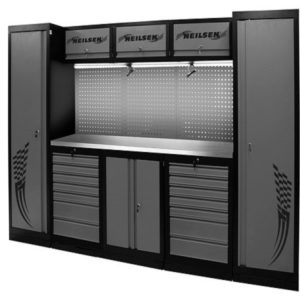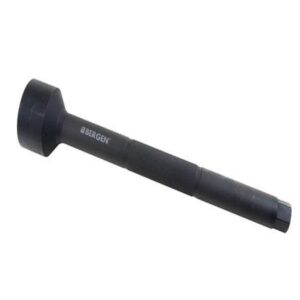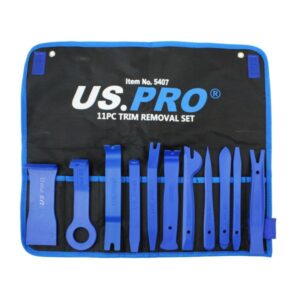Welzh Werkzeug Diesel High Pressure Pump Test Kit
£500.00 ex. VAT
Essential tool for accurately measuring the high pressure fuel circuit of diesel common rail systems.
Features 2,000bar gauge, pressure relief valve and high pressure flexible hoses.
The kit also includes a set of dummy pump regulator and injector pipe blanks.
Kit allows for a variety of tests to be conducted:
– Engine cranking/running pressure test.
– Maximum pump pressure test.
– Pump pressure regulator test.
– Injector leakage test.
-CE Approved
Instructions
Engine Cranking/Running Pressure Test
Step 1
Connect the gauge to the vehicle’s high pressure circuit. The engine will
operate normally; giving the actual fuel pressure reading.
Step 2
– Locate the high pressure pipe from the pump to the fuel rail. If it is
difficult to access, locate the pipes from the fuel rail to the injector.
– With the fuel system de-pressurised, disconnect the accessible high
pressure pipe and connect the gauge using either the M12 or M14 hoses.
– Ensure all hose fittings are fitted tightly prior to performing the next
steps.
Step 3
– Connect the diesel waste bottle (5) using a tube to the bottom of the
gauge. The bottle will collect the waste fuel when the pressure relief valve
is activated. A non-starting vehicle should still have a reading of 300 bar.
– While the engine is running carefully check that there are no fuel leaks
before proceeding to the next step. If there is a leak turn off the engine
and allow the system to de-pressurise before checking the fittings are
correctly sealed. Start the engine and check for leaks again.
Step 4
– Increase the engine speed ensuring that the fuel pressure increases
accordingly.
– Most importantly test that 300bar is reached with the engine idling
or activating the starter. If this pressure is correct, the low pressure
circuit is working correctly and the high pressure pump is supplying the
minimum pressure needed in order to start the engine properly.
– If the pressure is correct but the engine does not start, the problem
is not the high pressure pump, it could be an electrical fault, injector, etc.
Step 5
– If the pressure does not reach the required pressure test the pressure
at the inlet of the high pressure pump using a low pressure tester.
– If the pressure at the high pressure pump inlet is correct, check the
maximum pressure of the pump.
Maximum Pump Pressure Test
There are high pressure pumps that disconnect the third piston when
the required pressure is low. They only work with two pistons, whereas
the engine power requirement is less. The third piston is activated by a
solenoid when the 600-700bar is reached.
Step 1
– Connect the gauge to the vehicle’s high pressure circuit. This will not
allow the engine to start, and the testing is done with only the engine
cranking. Pressure should rise above the 1050bar showing that the
pump is operating correctly.
Step 2
– Locate the high pressure pipe from the pump to the fuel rail. If it is
difficult to access, locate the pipes from the fuel rail to the injector.
– With the fuel system de-pressurised, disconnect the accessible high
pressure pipe and connect the gauge to either M12 or M14 hose. Fit the
blanking plug to the gauge outlet. Ensure the hose fittings are tight prior
to proceeding.
Step 3
– Connect the diesel waste bottle (5) with the tube to the bottom of the
gauge. The bottle will collect the waste fuel when the pressure relief
valve is activated.
Step 4
– Crank the engine. The pressure should quickly rise above 1050bar.
This means the pump is operating correctly. If the pressure reading is
low it means the pump or the pressure regulator has a fault. Carry out a
pump pressure regulator test to identify the problem.
– NOTE: A problem with the pressure sensor (located on the fuel rail)
may send the wrong information to the PCM, thus giving the incorrect
information to the pressure regulator causing it open earlier than it
should. This will result in a low pressure reading. Use an EOBD tool
with live data and compare the actual pressure from the gauge to the
reading from the EOBD tool
Injector Leakage Test
– The injector pipe blanks is designed to be used together with the gauge and hose.
– This test should be carried out when the pump pressure does not reach 300bar;
not allowing the vehicle to start. By blanking the injector pipes it will show if the loss
of pressure is because of faulty injectors (sticking open.)
Step 1
– With the fuel de-pressurised, disconnect the high pressure pipes to the injectors
and fit the injector pipe blanks (4).
Step 2
– Follow the steps above for Engine Cranking/Running Pressure.
Step 3
– If the pressure has increased it means that at least one of the injectors is leaking.
– In order to identify which injector is leaking, connect the injector pipes individually
and repeat the test.
– If the pressure is still lower it might mean the pump or pressure regulator is faulty.







